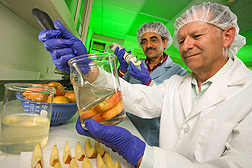This page has been archived and is being provided for reference purposes only. The page is no longer being updated, and therefore, links on the page may be invalid.
Read the magazine story to find out more. |
|
Making Fresh-Cut Apples Convenient and Safe
By Rosalie Marion BlissJuly 14, 2006
A new wash treatment developed by Agricultural Research Service (ARS) scientists provides antibrowning as well as antimicrobial benefits to fresh-cut apples.
Microbiologist Arvind Bhagwat led the project. He worked with plant physiologist Robert Saftner and horticulturist Judith Abbott. They are with the ARS Produce Quality and Safety Laboratory (PQSL) in Beltsville, Md.
Thanks to ARS research, managers at schools, grocery stores and restaurants nationwide have already been providing customers with sliced apples that stay fresh for several weeks. This ARS team now has discovered a dip solution--PQSL 2.0--that keeps sliced apples fresh and controls pathogens.
Volunteer sensory panelists tasted four slices of Fuji and four slices of Granny Smith apples. Each slice had been dipped that day in one of four different commercial or ARS wash treatments including PQSL 2.0. The panelists then reported any differences detected in aroma and flavor. All four treatments were found to maintain the apple slices’ cut-surface color, firmness, aroma and flavor similarly.
In a separate test, the researchers exposed five pathogens to fresh batches of each of the same four antibrowning wash treatments for two hours. Formula PQSL 2.0 reduced levels of all five pathogens in the wash solutions by 99.999 percent. PQSL 2.0 also came out ahead in reducing microflora on sanitized apples after slicing. Such native bacterial and fungal populations can accelerate spoilage over time.
Further preliminary studies have shown that a newer version of PQSL 2.0 controlled, or eliminated, two pathogens on apple slices. Low doses of Listeria and Salmonella had been put directly onto apple slices along with the new formula, and the pathogens were found to be inhibited, or completely eliminated, after one, two and three weeks.
Read more about this research in the July 2006 issue of Agricultural Research magazine.
ARS is the U.S. Department of Agriculture’s chief scientific research agency.

